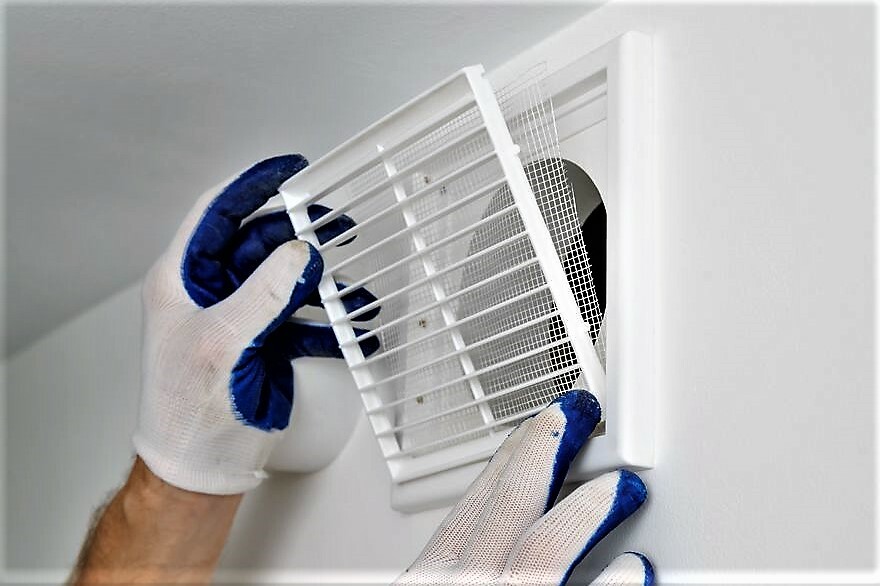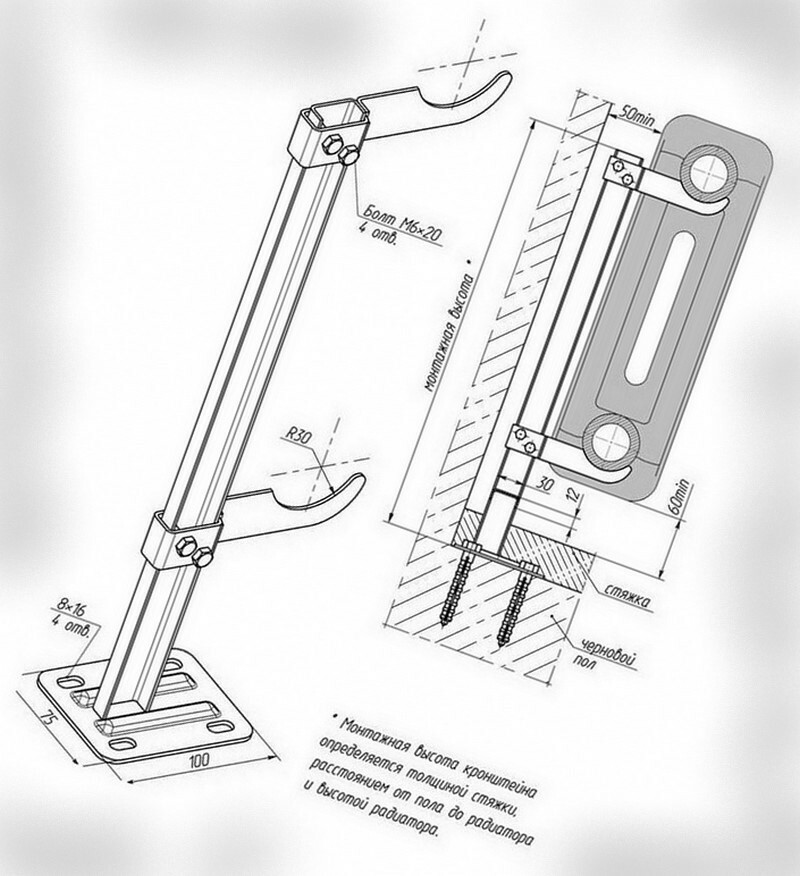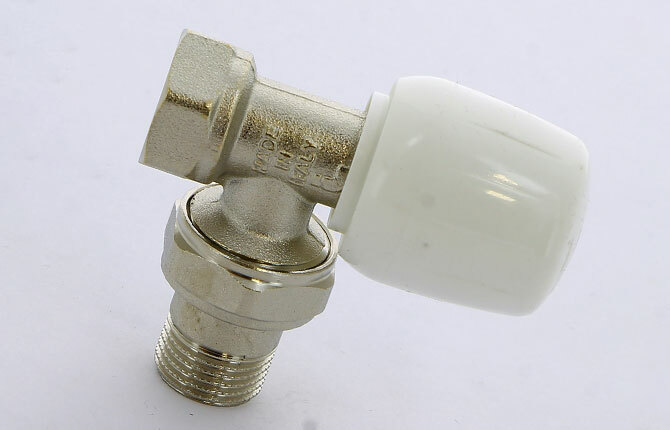Heating radiators are elements of engineering plumbing systems, functionally designed to heat the room air. According to SNiP (2.03.01-84), radiators corresponding to the calculations of the heat balance should be used in any room. To maintain the normal temperature inside buildings, they are quite enough.
However, for a garage or a small workshop, it’s better to do a heating register yourself. In terms of dimensions and heat transfer, this device goes beyond the parameters of classical constructions, but it is much more suitable for the indicated rooms. In the article submitted by us in detail the technology of its manufacture.
The content of the article:
- Homemade heating registers
- How to calculate the heat transfer?
- The choice of the configuration of the heater
-
Instructions for the manufacture of the radiator
- Pipe preparation and welding
- Assembling the heating battery
- Features of the design "snake"
- Difference profile registers
- Conclusions and useful video on the topic
Homemade heating registers
Increasing the area of heat exchange and the volume component of the coolant, of course, to achieve the desired temperature in the room is easier. Therefore, quite a few property owners, taking advantage of the lack of application of selection controls heat at each specific point, increase heat removal by making non-standard radiators designs.
In fact, this is prohibited, as it seems to be an irrational approach to energy consumption. In practice, they think less about resources than about their own well-being. With options for economical heating garage will introduce next article, the content of which we advise you to read. But more to the point.

A heating register made by hand and installed in one of the utility rooms for technical purposes. This is a four-pipe circuit solution with the supply and discharge of heat transfer fluid on one side.
Making a heating register personally is a relatively simple task, especially if you have the skills of a welder and have a welding machine at hand. It will only be necessary to purchase pipes of suitable diameter and sheet metal in the right quantity.
How to calculate the heat transfer?
The required amount of material can be calculated based on the temperature parameters that are required to obtain in the room. At the household level, this step is usually passed - do the heating registers with their own hands "by eye" according to the principle "the more the better."
But it is better to make simple calculations of heat transfer, for which you do not need to be a mathematician. It only takes:
- Calculate the area of the room.
- Learn about the properties of heat transfer steel.
- Choose the optimal pipe diameter.
The area of the room is calculated by multiplying the size of its length by the size of the width (S = L * W). However, for more accurate calculations, it is recommended to calculate the volume parameter, adding the height value (H) to the calculations.
Thus, the final calculation formula takes the form:
V = L * W * H
For example, it is required to calculate the V room, where the length is 5 m, the width is 3 m, the height is 2.15 m. The volume of the room is obtained: V = 5 * 3 * 2.15 = 30.25 m3. Based on this basic value, further calculations should be made, determining the amount of heat, the size and number of heating registers for the manufacture of their own hands.

Welded heating registers are blocks consisting of six steel pipes with a diameter of over 100 mm. Such batteries, made without proper calculation, can overheat the room being serviced.
First of all, the required amount of heat is calculated per calculated room volume to achieve the required internal temperature (W):
Q.pt = V * k (Tвн - Tнар),
where V is the volume of the room; k is the heat transfer coefficient of the building walls; Tvn - the temperature inside; Tnar - outside temperature.
The amount of heat emitted by one register can be calculated by the formula:
Qp = q * L * (1-n),
where: q is the heat flux from each horizontal and vertical tube of the register (approximately 20-30 W / m); L - length vertical and horizontal register tubes (m); n is the coefficient of unaccounted heat flows (for metal pipes - 0,1).
The category of unaccounted heat loss also applies exhaust hood in the garage. If the mechanical type is set, the coefficient n is required to increase to at least 0.2.
The number of registers, respectively, is determined by the formula:
Np = Q.p. / Qр
This method of calculation by design experts will most likely be evaluated as a simplified and rough form. However, such an approach is still seen as a more rational action than calculation and production of registers with their own hands on the eye, without any calculations.
The choice of the configuration of the heater
Homemade radiator designs are mainly made on the basis of metal pipes with a diameter of 80 - 150 mm.
Design features are limited to two versions:
- Lattice.
- Snake.
The grid design of the heating battery differs from the “snake” by a somewhat different construction of the circuit, and, depending on variations in such batteries, the distribution of the heat carrier may be different.

Variants of schematic construction of heating registers for their own production: 1 - one jumper and one-way power; 2 - two jumpers and one-way power; 3 - two-way power and 2 jumpers; 4 - two-way power and 4 jumpers; 5, 6 - multitubular
Coil constructions actually have a uniform design, suggesting a strictly consistent movement of the coolant.
Lattice registers are built according to different schematics:
- with one or two jumpers and one-way power;
- with one or two jumpers and versatile power;
- parallel inclusion of pipes;
- sequential inclusion of pipes.
The number of pipes of one assembly can be from two to four or more. Rarely, but there is also the practice of making single-pipe registers.
A coil assembly usually contains at least two pipes connected on one side with a deaf jumper, on the other - a passage bridge that is made of two pipe branches (2x45º). It should be noted that the execution of heating registers in the form of a coil is used much less frequently than the “grid” construction.

Variants of the possible manufacture of registers type "snake". For coil register battery designs, the choice of manufacturing options is limited compared with lattice-type designs.
Both production options - lattice and coil - can be made not only on the basis of classical round, but also on the basis of shaped pipes.
Profile pipes are seen as somewhat specific material, as they require a slightly different approach when assembling radiators. However, registers from a profile pipe are more compact and occupy less usable space, and this factor is also important.
Instructions for the manufacture of the radiator
In order to make the heating register with our own hands, it is recommended to carry out the necessary calculations initially (as described above). And it's not about saving resources, but about making batteries really useful in all respects.
Experiencing the winter period with open vents - this option is suitable for walrus. All others who are not in the group of seasoned people risk a severe cold. And powerful radiators are just as bad as they are too weak.

Pipe register for heating, made by himself. This design of the heating battery is distinguished by non-standard coolant supply. Water is supplied and discharged through pipe risers to which the register pipes are directly connected.
So, the calculation is made, you can proceed to the choice of material.
An economical and quite suitable choice for a self-made construction can be considered steel pipes and manufactured for steel pipes fittings to them:
- elbows (suitable for pipe diameter);
- corners (reinforcement);
- steel sheet (thickness equal to pipe wall thickness);
- branch pipes (pipes of small diameter).
Valves may also be required, which are often not installed directly on the registers. Production skills and knowledge would be useful gas welding technologyif they have a future performer.
Pipe preparation and welding
According to the calculated parameters of length, the pipes of the future radiator are cut to size. For cutting the convenient tool - a circular saw. Then from the metal sheet cut plugs at the ends of the pipes. It is convenient to cut the round shape of the plug with an oxygen cutter.
First of all, on the surface of the metal sheet with chalk mark the circles of the desired diameter and then carefully cut. Part of the sliced pancakes (count count) is made with holes for the inlet and outlet connections of the heat carrier.

Caps for register pipes in the factory version. Such plugs are more preferable for installation in self-made batteries. A varied assortment allows for a wide selection.
It is also immediately recommended to cut holes (one or two, depending on the project of assembly) in the wall of each pipe, with a distance of 100-150 mm from the end edge. These openings are intended for pipe joining during battery assembly.
After cutting the holes, it is recommended to clean the inner area of each pipe from slag and scale. Next on the ends of the pipes put pancakes and scald qualitatively in a circle. On the first and last pipe brewed in one pancake with a hole.
Assembling the heating battery
Finished pipes must be combined into a battery. To do this, they are determined with the configuration of the radiator (if it is decided to manufacture the lattice structure). Based on the adopted configuration choice, jumpers are prepared - continuous and blind.
The material for the jumpers are usually small diameter pipes. For example, d = 25 mm or d = 32 mm. Also prepare tubes for supply / return pipes (length 150-200 mm, diameter 25-32 mm).

Work on the assembly of the register of heating with their own hands. For ease of fitting and precise assembly, the workpieces are placed on a flat surface. In this case, all the details are laid on a stone platform.
The pipes (2 - 3 - 4) prepared for the heating register are laid out on a flat surface, aligned along the end edges. The first (upper) and last (lower) are laid out with end edges with holes, according to the selected connection scheme: one-way (input and output on one side) or two-way (input and output on different parties).
It will only be necessary to carefully weld the bushing and blind bridges between the pipes, the inlet and the outlet, after which the heating register is ready for installation in the system. Before work the beginning master will need to study electric welding rules, described in detail in the article devoted to this question.
Features of the design "snake"
Serpentine register is going a little different. Here, instead of vertical jumpers, metal bends are used, with the help of which the end parts of individual pipes are connected.
To assemble a snake register, you must:
- Lay out the pipes on a flat surface.
- Cook from arc 45º bends.
- Connect arc pipes to each side with arc taps.
- The initial and terminal end of the first and last pipe to close the plugs with pipes.
Coil heating registers are large-sized by limiting the possibility of adjusting the annular distance. In this regard, the "snakes" are superior in their parameters lattice structures. However, from the point of view of the efficiency of the coolant stroke, the “snake” looks like the preferred option.

An interesting example of a coil register, made no longer with his own hand, but at the factory. Industrial production conditions make it possible to make more sophisticated devices (with heat dissipating ribs)
There are practically no air jams inside such registers, which is typical for products of the type "lattice". due to large-diameter arc taps, coil structures have less hydraulic resistance. Nevertheless, they make such registers with their own hands quite rarely.
Difference profile registers
An interesting construction compared to those described above is a register made of a shaped tube. More compact, but no less efficient batteries are collected almost on the same technology.
The features of the assembly can be noted only in the preparation and fitting of the annular bridges. As a rule, welding is not used here. It is enough to have a good metal-cutting tool.

An example of the manufacture of a thermal register of shaped pipes. The design of "snake" turns out more compact, than from smooth round pipes. Meanwhile, the efficiency of the device on the profile pipes is no worse than traditional
The ends of the annular jumpers and directly register pipes are cut at an angle of 45º, ensuring an exact match on the faces on the connection line. If the register of the lattice type is being assembled, the annular web is made with angular sections at the ends and straight cuts at the points of supply of the central pipes.

This is obtained register heating battery, made according to the grid. Neat appearance and quite convenient form for installation in living conditions
After preparation, the jumpers are put in place and carefully scalded. On the "snakes" in addition to put a solid reinforcing bar parallel to the pass.
Self-made registers were widely used for domestic needs in the recent past. Now this type of heater is used less frequently.
An alternative to registers, especially if the garage is not connected to a centralized heating system, would be miracle stove on diesel. With the method of its manufacture will introduce our proposed article.
Conclusions and useful video on the topic
You can learn about the production sequence of the heating register from a profile pipe and welding secrets from the video:
Self-made heating equipment is actively continued to be made and operated in rural areas or in private industries for heating service premises. But many refuse to use such unsustainable structures, especially where metering and control devices for coolant consumption are introduced.
Want to talk about how to assemble a register for the garage or to give with your own hands? Have information that can be useful for independent home craftsmen? Please write comments in the block below, share useful information and photos on the topic of the article, ask questions.


